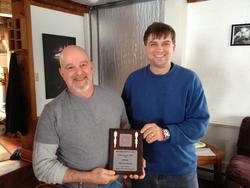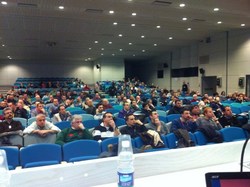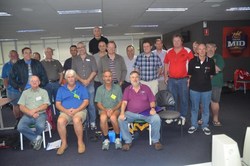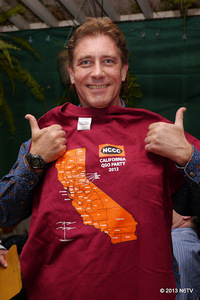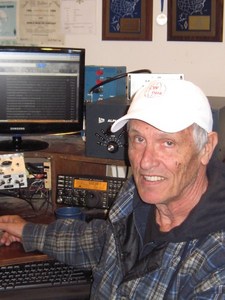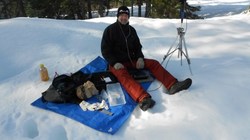 March 27, 2013 Editor: Ward Silver, NØAX | |||||||||
IN THIS ISSUE
NEW HF OPERATORS - THINGS TO DO Even a little pistol can be a star attraction in the CQ WPX (Worked PrefiX) contests in which a 2-by-3 call sign is often a new multiplier. Plus, you can make strides towards your WPX award while you're contesting. National DX contests from Bulgaria, Hungary, and Poland are taking place, too, along with the Missouri QSO Party - spring has sprung! BULLETINS There are no bulletins in this issue. BUSTED QSOS The North American Phone Sprint date was grouped improperly in the contest summary last time - apologies for anyone misled or delayed. CONTEST SUMMARY Complete information for all contests follows the Conversation section March 30-31
April 6-7
Based on the strong positive response last year, the Florida Contest Group announces that they are bringing back the 1x1 spelling bee for the 2013 Florida QSO Party, April 27 - 28. Stations that work all seven of the 1x1 calls to spell "FLORIDA" will receive a special certificate. (Thanks, Chris WF3C) Scott, N3FJP announces the release of VHF Contest Log 4.0, replacing both VHF Contest Log 3.0 and VHF Network Log 2.5. The new program supports both Fixed and Rover stations for the ARRL VHF+ contests and CQ World Wide VHF.
It is a shock to report the sudden death of Luis Chartarifsky XE1L just after he returned to the mainland following the recent TX5K expedition to Clipperton Island. Luis was an active DXer and contester with numerous expeditions to his credit, a member of the A-1 Operators Club and received numerous other accolades throughout his ham career. (Thanks to DXXE) While reading the just-released CW Sweepstakes extended results for 2012 you might wonder where that long exchange came from. Basing its exchange in part on the radiogram header, Sweepstakes owes a lot to long-time ARRL staffer, George Hart W1NJM, the father of the National Traffic System. George died on Sunday, March 24th at the age of 99. A memorial service is planned for late April. (Thanks, Pete W1RM) With many QSO parties starting to align their dates, Chuck NO5W has added support for concurrent operation of the multi-QSO party consisting of MIQP, SDQP, NDQP, ONQP, and NebQP in the next update of his CQ/X software. Patch 180-03 is scheduled to be released by the end of this month. Download version 1.8.0 and the three patches from www.no5w.com.
Ash KF5EYY is better known as 3V8BB and 3V8SS in contests, such as the ARRL DX CW contest in February. He has made it possible to hear your ARRL CW 2013 QSO with 3V8BB during online. Daniel K7DGL found a cool new product - the SatSleeve from Thuraya - a case that turns an iPhone into a satellite phone capable of voice and SMS messaging. The Thuraya service does not cover the Western hemisphere, but it's not unreasonable to expect Inmarsat or Hughes to be thinking about similar products. If you have more than one manufacturer's handheld radio, you'll be glad to hear of an open source tool used to program different radios called CHIRP. At the moment it covers the basic programming needs - frequency, tone, offset, etc - of a wide variety of handhelds. Since it is an open source project, there may be additional features added in the future. (Thanks, John KF5KI)
ARRL Bulletin 007 tells us that the FCC has granted the ARRL's request for a temporary waiver to allow TDMA (time division, multiple access) emissions by amateurs above 30 MHz. This takes a lot of persistent effort that is rarely visible to hams and I don't know of another organization than the ARRL that has enough credibility and resources to cause it to happen - a good reason to support the ARRL. A tip of the Contest Update cap to the team charged with getting this done. Web Site of the Week - As many of us discovered through our early ham radio adventures, an FCC license can also lead to a professional career. The burgeoning population of makers is also finding this out as in the EDN article, "DIY movement Sparks Engineering Education" by Louis Frenzel W5LEF. This article is one of several recent articles about education and engineering in Frenzel's blog. WORD TO THE WISE Iron bottom - a contester with a very high number of operating hours in a contest. Doug KR2Q has provided us with the iron bottom results from a recent CQWW SSB contest: ~50% operate for 8 hours or less Leaving ~5% iron-bottoms out there - and you know who you are! The following upcoming programs have been scheduled (dates are North American local time):
Click on the WWROF website's link to Webinars, then Upcoming Webinars for details and registration. (Thanks, Ken K4ZW)
The Northern California Contest Club (NCCC) recently held their annual awards dinner and Bob N6TV posted a lot of excellent photographs of the plaque winners in his excellent online album. This video from AMSAT-UK is an excellent interview describing NASA's CubeSat Launch Initiative and how it enables students and professionals to launch their own satellites. (Thanks, Brent KB1LQD) A winter's day can be a fine time for a short hike with a little QRP operation for seasoning as recounted by Jim W1PID in this recounting of his hike to the Pemigewasset River. CQ Records? It's not what you think! (Thanks, George K5TR) Another scherzando penseé to the magic of radio comes from guitarist extraordinaire, Leo Kottke, in this online video of his song, "Shortwave". (Thanks, Sean KX9X) The extended results for the ARRL's CW Sweepstakes by VE4XT and the International EME Contest by K1DS are online. All certificates for the 2012 ARRL DX CW Contest have been processed, to be quickly followed by the ARRL DX Phone certificates. (Thanks, ARRL Contest Branch Manager, Sean KX9X) Preliminary results for the January North American QSO Party CW and SSB contests are now on the National Contest Journal web site. The contest managers and writeup authors are always looking for interesting stories and photos - see the NCJ website for contact information. (Thanks, NAQP SSB Manager, Bill ACØW)
A CWops Test Hat Trick means winning all three sessions on a single Wednesday/Thursday. So far, the only one to do it is Howie N4AF (photo at right) who has done it THREE times. That means Howie has accomplished a CWops Test Hat Trick Hat Trick. But can he chop wood? (Thanks, Hank W6SX) The results of the 2012 Ohio QSO Party have been posted on the OhQP web site. (Thanks, Jim K8MR) OPERATING TIP Many of us will recognize Contester's Crouch - sitting in front of a radio or a computer screen, head forward, shoulders hunched, ready to pounce. It's instinctive, maybe, but not very healthy. There are a number of health conditions that make "the crouch" painful and put severe limits on operating time. Pete N4ZR got relief through placing a large lumbar-relief cushion on his chair to shift his posture. If you aren't comfortable when operating, take the necessary steps to make things better - you are never too young to start taking care of your back! If you're interested in VOCAP, Carl Luetzelschwab K9LA has posted a VOCAP tutorial on the ARRL website. Carl is also hosting a WWROF webinar on solar topics as mentioned in the Sights and Sounds section above.
From Frank W3LPL on the1921 "Transatlantics" - "The 1BCG transmitter was redesigned and rebuilt many times before and during the Transatlantic Test. The transmitter as first built in early December was a "self rectified A.C. self oscillator" design, but Armstrong was very dissatisfied with the roughness of the transmitted signal. On 4 December it was decided that the transmitter should be rebuilt as a Master Oscillator - Power Amplifier" (MOPA) with a 2000 volt DC motor generator power supply. It wasn't until the third day of the Tests (December 9) that the transmitter was fully functional with an estimated 600 watts power output. Propagation was very poor and atmospheric QRN was very high after the night of 11/12 December, and Godley heard no further transatlantic signals. Out of frustration and with only a few days remaining before Godley was scheduled to depart from Scotland, another 2500 volt motor generator was rushed to 1BCG and connected in series with the original motor generator, with 4500 volts now applied to the PA. That configuration was used for the last few days of the Transatlantic Test and during the next two weeks when 1BCG made two way QSOs with every state of the union." A kilowatt or more of CW in 1921? Awesome! As a point of interest, Frank noted, "It would be many years before two way transoceanic QSOs took place on 160 meters. For many years all of the effort was focused on opening transoceanic DX on the higher frequencies, all the way up to 5 meters!" ARRL Propapagation Bulletin 011 mentions a handy tool for converting a street address into latitude/longitude coordinates. It is useful for determining locations for propagation prediction and other programs based on FCC database address records or for your own location. From Slashdot comes a recommendation of this list of important dates relevant to computer programs, algorithms, and operating systems - just in case you needed something else to worry about! EDN magazine often reprints popular designs from years past for which a need still exists, such as this analog notch filter to remove 60 Hz interference. While aimed at the robotics designer, Servo City's selection of small aluminum beams looks like there is lots of potential for building small antennas and other jobs around the ham shack. Pete N4ZR has been busy! "Before last weekend's (ARRL DX) contest, I had a chance to experiment a bit with my voice recordings. One of the problems I have always had is that when I try to enunciate clearly I slow down and the resulting recording lacks the urgency you expect in a contest situation. I also notice stations whose recorded and live audio don't sound anything alike and wanted to minimize that as much as possible." Here is a method Pete found of using the Audacity audio software tools to speed up the recording while still keeping enunciation crystal clear. The first electrostatically-driven graphene speaker matches or outperforms commercially available earphones according to this article. Lighter is good, particularly on those long contest weekends when you're in "iron bottom" mode. (Thanks, Brian K1BRF) This week's Instructables project for the ham shack is this clever adaptation of a stepladder to form a set of shelves for books, parts, or gear. Change that wobbly old ladder into furniture! Many digital contesters are aware of DL4RCK's RCKSkimmer software, which allows skimming of RTTY and other digital signals by scanning for them with a conventional receiver. Now Wes, WZ7I has come up with an ingenious way to generate seven bands of CW spots and two additional bands of digital spots, all from a single QS1R receiver. The Reverse Beacon Network is ready for digital spots - this will definitely increase the number of spots available to digital DXers and contesters worldwide. (Thanks, Pete N4ZR)
Technical mavens would do well to check out the project-packed web page of Jim VK5TR. I can smell the soldering irons heating up now! Technical Web Site of the Week - In searching for WWVB information, Jerry WAØACF found an interesting NIST publication containing the history of WWV and all of its variations and locations. He says, "I thought it was interesting to learn that the second WWV time announcer was replaced because he didn't sound enough like the first time announcer." I Can Hear You Now! I mentioned hearing aids and contests previously in the May 11, 2011 issue of the Contest Update. Recently, I upgraded my hearing aids (I wear one in each ear) to a pair of ReSound Forza in-the-ear models. These are nice digital aids with some interesting features but the one that will interest most of my readers is the Bluetooth wireless capability that links the aids to an "audio streamer" which, in turn, plugs into a source of stereo audio, such as a TV or...a ham radio! I really liked being able to clearly hear the TV audio piped directly into each ear - wow, dialogue, who knew? - so the next stop was to the shack to see how they sounded on the bands.
My grand experiment took place during the January CW NAQP with an SO2R setup and during casual operating since. Usually, I wear lightweight open-air headphones while contesting unless there is a lot of local noise that requires noise-cancelling or closed-muff models. In this case, I was the only one at home so this was a great opportunity to try the hearing aids and the wireless connection. It worked great! I set up the streaming device and plugged it into the headphone jack. To activate the link, I press-and-hold the program select button. The linked-up tones sound and - voila! - full ham radio audio just if I was wearing headphones. I moved the streamer to my audio switchbox and again, audio just as good as headphones. (To be sure, the bass registers are not reproduced by the hearing aid with or without the Bluetooth link, but this is not an issue copying CW or most SSB.) Furthermore, I could get up and wander around without losing the link - maximum range is about 15 feet before dropouts start occurring. So I operated with and without headphones during the contest and found the wireless hearing aids to be fine. The only issue I have had with the wireless link is that prolonged use drains the small 312-size batteries in less than a day. You'll want to put in fresh batteries before the contest and have spares on hand for when they run down. Changing both batteries takes about 20 seconds if you're in a hurry. Gary, AB9M experimented with the T-coils intended for picking up telephone handset audio. "In many hearing aids the T-coil program has a separate profile since normal telephone audio frequencies are from 300 to 3000 Hz with a 6 dB per octave rising response providing equal loudness." Gary's open-style hearing aids don't work well with regular T-coils and headsets due to the combination of external sound and the inductively-coupled sound. He recommends instead J-hooks which provide no external sound, but do inductively couple to the T-coils of my hearing aids to produce sounds inside my hearing aids. He can now copy CW, chase DX, or participate in an nets, even as net control! There are a lot of hams with hearing loss - young and old - out there. If that's you, there are more and more options available every day as hearing aid technology advances. Don't let hearing loss be a reason to go QRT. 27 March through 9 April An expanded, downloadable version of QST's Contest Corral in PDF format is available. Check the sponsor's Web site for information on operating time restrictions and other instructions. HF CONTESTS CQ WPX SSB Contest--Phone, from Mar 30, 0000Z to Mar 31, 2400Z. Bands (MHz): 1.8-28. Exchange: RS and serial. Logs due: Apr 6. Rules Poisson d'Avril--Phone, CW, Digital, Mixolidian, from Apr 1, 0059Z to Apr 1, 2359Z. Bands: 1970s classic rock is preferred, although a little jazz is good now and then. Frequencies: operate as long as you can stand it. Exchange: all awards are final and cannot be exchanged no matter how much you want to - you operated in the contest, didn't you? Logs due: they are due mostly to the vast amount of cheating in this contest, which is encouraged and often celebrated. Rules Low Power Spring Sprint--CW, from Apr 1, 1400Z to Apr 1, 2000Z . Bands (MHz): 1.8-28. Exchange: RST, grid square, category. Logs due: 30 days. Rules ARS Spartan Sprint--CW, from Apr 2, 0200Z to Apr 2, 0400Z. Bands (MHz): 3.5-28. Monthly on the first Monday evening local time. Exchange: RST, S/P/C, and power. Logs due: 2 days. Rules OK1WC Memorial Contest--Phone,CW, from Apr 2, 1600Z to Apr 2, 1659Z. Bands (MHz): 3.5, 50,144. First through fourth Monday of each month; see website for bands. Exchange: RS(T) and serial. Logs due: 7 days. Rules NS Weekly Sprint--CW, from Apr 5, 0230Z to Apr 5, 0300Z. Bands (MHz): 1.8-14. Weekly on Thursday evenings local time. Exchange: Serial, name, and S/P/C. Logs due: 2 days. Rules LZ Open 40 Meter Contest--CW, from Apr 6, 0400Z to Apr 6, 0800Z. Bands (MHz): 7. Exchange: 6-digit serial and serial from previous QSO. Logs due: 10 days. Rules PODXS 31 Flavors Contest--Digital, from Apr 6, 12 Noon to Apr 6, 6 PM. Bands (MHz): 14. Frequencies (MHz): 14.070-14.080. Exchange: S/P/C and name or 070 number. Logs due: May 8. Rules QRP ARCI Spring QSO Party--CW, from Apr 6, 1200Z to Apr 7, 2359Z. Bands (MHz): 1.8-28. Frequencies (MHz): QRP calling frequencies. Exchange: RST, S/P/C, power or QRP ARCI number. Logs due: 14 days. Rules SP DX Contest--Phone,CW, from Apr 6, 1500Z to Apr 7, 1500Z . Bands (MHz): 1.8-28. Exchange: RS(T), serial or SP province. Logs due: Apr 30. Rules EA RTTY Contest--Digital, from Apr 6, 1600Z to Apr 7, 1600Z . Bands (MHz): 3.5-28. Exchange: RST, serial or EA province. Logs due: Apr 27. Rules Missouri QSO Party--Phone,CW, from Apr 6, 1800Z to Apr 7, 0500Z. Multiple operating periods. Bands (MHz): 1.8-28. Frequencies (MHz): CW 1.820 and 40 kHz from band edge; Phone - 1.880, 3.825, 7.220, 14.250, 21.380, 28.350. Exchange: RS(T), serial, MO county or S/P/C. Logs due: May 1. Rules VHF+ CONTESTS VHF Spring Sprints--Phone,CW,Digital, from Apr 1, 7 PM to Apr 1, 11 PM. Bands (MHz): 144. Exchange: Grid square (6-character preferred). Logs due: 14 days. Rules OK1WC Memorial Contest--Phone,CW, from Apr 2, 1600Z to Apr 2, 1659Z. Bands (MHz): 3.5, 50,144. First through fourth Monday of each month; see website for bands. Exchange: RS(T) and serial. Logs due: 7 days. Rules Stark County (OH) VHF QSO Party--Phone, from Apr 6, 12 Noon to Apr 6, 4 PM. Bands (MHz): 144, Frequencies (MHz): FM simplex only, avoid 146.52. Exchange: Call sign and QTH. Logs due: May 4. Rules LOG DUE DATES 27 March through 9 April
ARRL Information Click here to advertise in this newsletter, space subject to availability. Your One-Stop Resource for Amateur Radio News and Information ARRL membership includes QST, Amateur Radio's most popular and informative journal, delivered to your mailbox each month. Subscribe to NCJ - the National Contest Journal. Published bimonthly, features articles by top contesters, letters, hints, statistics, scores, NA Sprint and QSO Parties. Subscribe to QEX - A Forum for Communications Experimenters. Published bimonthly, features technical articles, construction projects, columns and other items of interest to radio amateurs and communications professionals. Free of charge to ARRL members: Subscribe to The ARRL Letter (weekly digest of news and information), the ARES E-Letter (monthly public service and emergency communications news), Division and Section news -- and much more! ARRL offers a wide array of products to enhance your enjoyment of Amateur Radio. Visit the site often for new publications, specials and sales. Donate to the fund of your choice -- support programs not funded by member dues! Reprint permission can be obtained by sending email to permission@arrl.org with a description of the material and the reprint publication. ACKNOWLEDGEMENTS ARRL Contest Update wishes to acknowledge information from WA7BNM's Contest Calendar and SM3CER's Contest Calendar. | |||||||||
